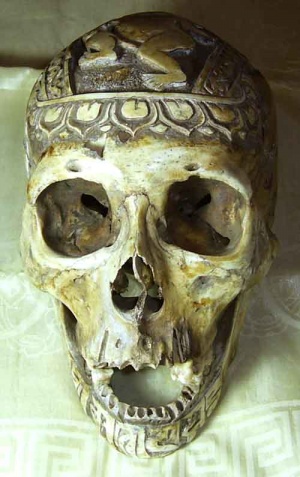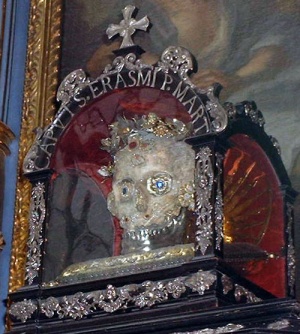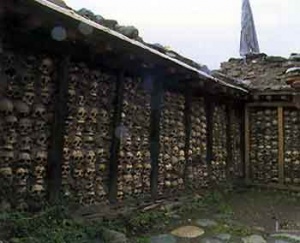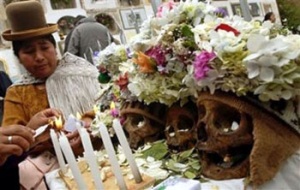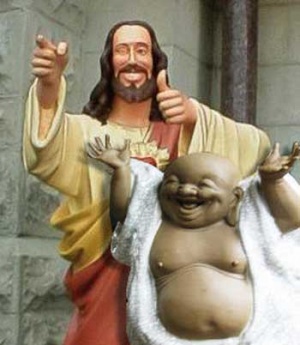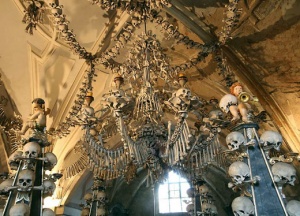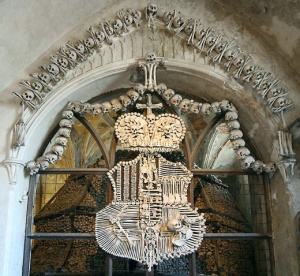Tantric Ritual Objects Formed Of Human Bones
One of the more unnerving aspects of Tantric Buddhism (as well as the Bön tradition) is the host of wrathful divinities as well as that fact that from time to time one encounters among the most placid of ritual objects other ritual objects crafted from human skulls, tibias and even human skin.
While I make no claims to expertise on the subject, I thought that it would be constructive (within the limits of my modest abilities) to attempt to clarify this issue, to gather together and comment upon here a certain amount of rare photographic documents regarding the use of these sacred objects made of human bone within Tibetan Buddhist practices. I do not pretend
to have fully explored this issue and have had quite a time of it putting together this page, among the details revealed only during empowerments which I have no authority toreveal, those of which I am ignorant, and that which has seemed to me beside the point - and sometimes I have simply had to shut up.
Equally, I have thought it useful to align these aspects of Tibetan Buddhism with those of other religious traditions, including the Christian!
[[File:Damaru221.jpg|centre|thumb|300px|Another example of a human skull damaru)]
[[File:Chod.jpg|centre|thumb|300px|Antique photograph of a Chöd practitioner - notice the trumpet made of a human tibia (in Tibetan: "Kangling")]]
In the Buddhist Tantric traditions, the use of human bones to fabricate sundry ritual instruments is considered primarily to bring to mind the reality of impermanence, the practitioner being led to meditate upon the fact that one
day...and perhaps sooner than he thinks...his existence too will be reduced down to a few paltry objects. One finds similar meditative considerations in the Theravadin traditions, certain temples keeping skeletons on display as a reminder to the monks of their impermanence. Some monastic ascetics used to take for their sole object of meditation a piece of human bone, this practice was still alive in the 1960's.

(From the temple of the most Venerable LP Tim, Thailand)
The second aspect, more difficult to explain to the uninitiated, is related to the secret aspects of the Vajrayana, arises from the fact that the Vajrayana is a vow of complete realization which undertakes to put to use absolutely ALL of life's appearances in the sole aim of leading the disciple to Awakening in the course of only one incarnation, thus the host of divinities
multicolored and multiform, each one precisely symbolizing an aspect of the practitioner's life. This is why one meets (among others) sexual divinities in copulative union (Tibetan: "Yab Yum"), a Medicine Buddha, a Buddha of Compassion....
Thus the recollection of death, along with the aversion and fear it inspires are used as potent methods to induce the natural workings of his mind to lead to the disciple's awakening. Thus one finds in every prayer wheel a human bone bead for example, which shows clearly that the use of bones are neither to frighten nor to shock.

Another condition which explains more simply the extensive use of human and animal bones in Tibet is, very simply, the lack of...wood! Almost all wooden objects had to be imported from India via yak - obviously wood had to be set aside for purposes for which it is indispensable (building temples, woodblocks to print the sacred texts...) Thus bone was used
instead of wood and it was permissible for artisans to create from bone quantifies of sacred objects, evolving remarkable art forms. The tradition, however, of using human bones to make ritual objects has followed the Tibetans into exile (for ritual objects), even where wood is less difficult to obtain.
The following visual examples show that the use of death representations (momento mori) made of human bone is not somethingunique to Tibetan Buddhism but actually is quite often found at the core of various religious traditions across the planet.
The similarities between the medieval Christian danses macabres (death dances) and the Tibetan Citipati is troubling.
st barthelemy
This medieval statue of St Barthelemy, showing him skinned alive, covered in blood, with his skin on his harm and a knife in his hand go without comments...
Please show it to any Christian who say he is "shocked" by the Tibetan ritual objects or by a "wrathfull deity"
This St Barthelemy statue is displaid in the Chapelle de la Trinité, in Cleguerec (Morbihan, France)
At this point we can see clearly that the Tibetans are far from being the only ones to make cult objects of carved human skulls and guarded piously as relics.
Again, the resemblance between certain Christian relics and Tibetan cult objects is striking!
All religious controversy is silly, as the Masters well know!
The following photos are presented as a small demonstration that the Christian religion is far from being "innocent" of the use of human remains and macabre relics - the faithful who feel called upon to publicly criticize the customs of Tantric Buddhism are invited to contemplate these images...
Moreover, while speaking on this subject, to contemplate too the fact in the Catholic religion the faithful are forced symbolically to consume human flesh and blood during the course of the mass.

Source

)

